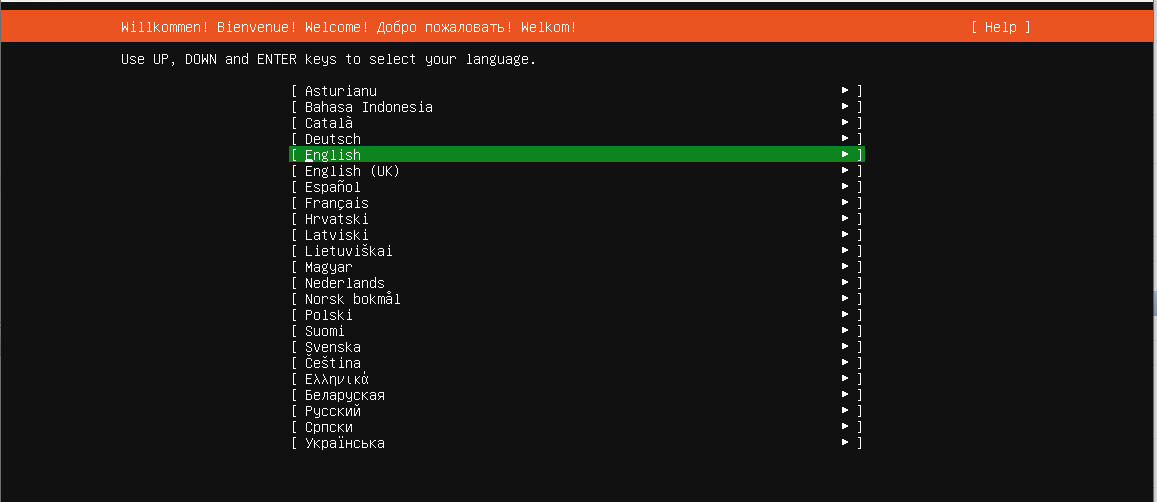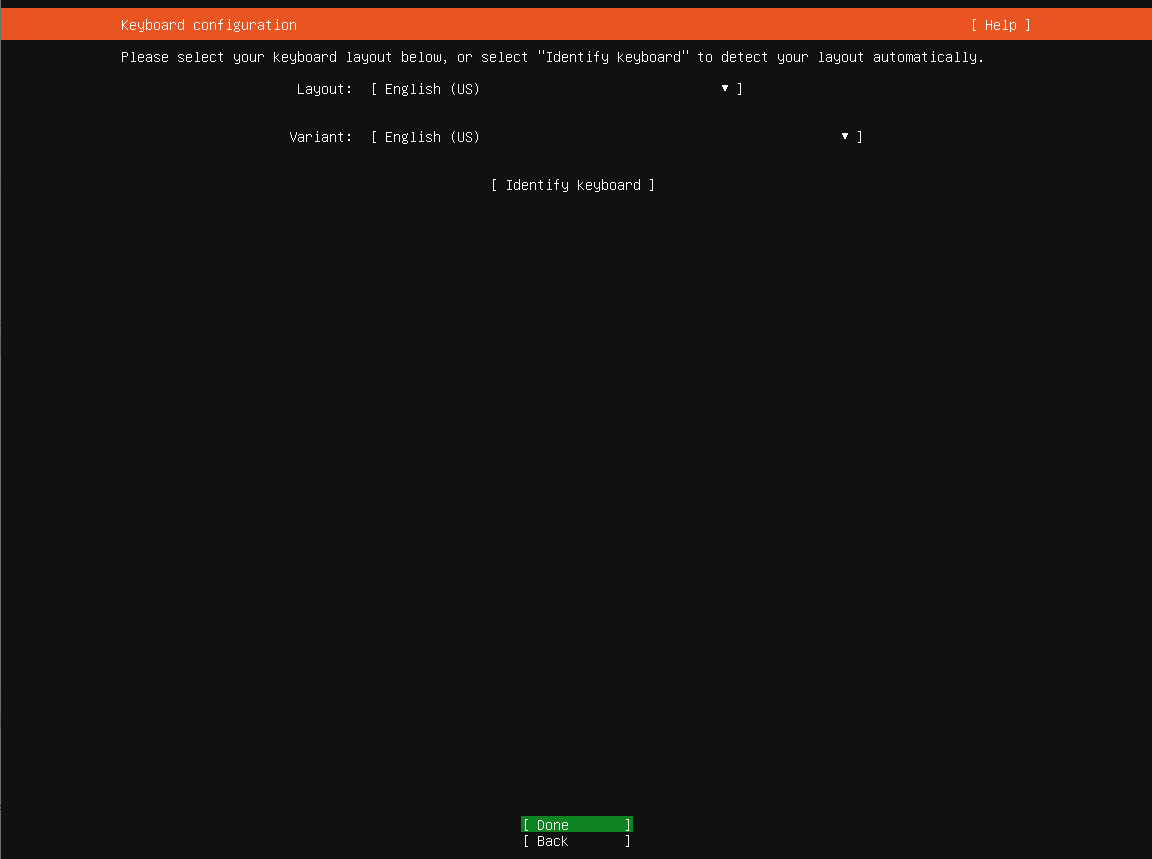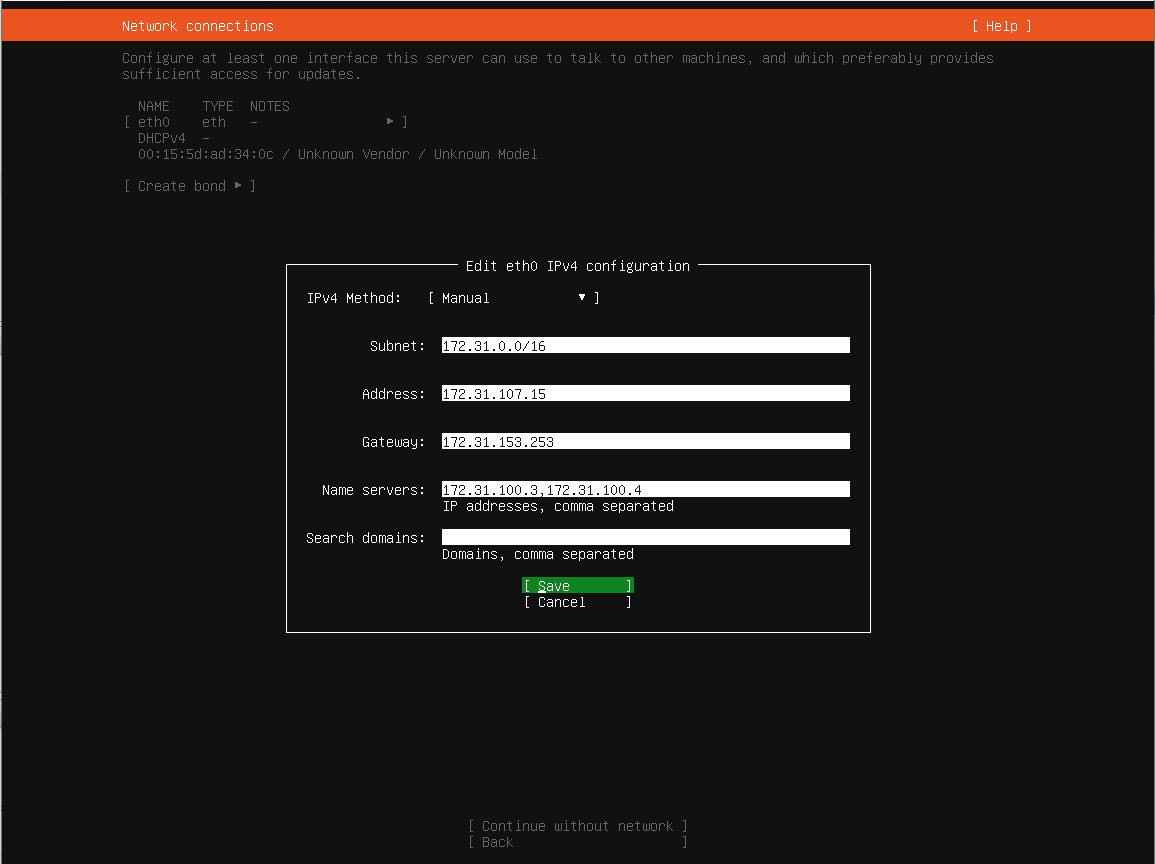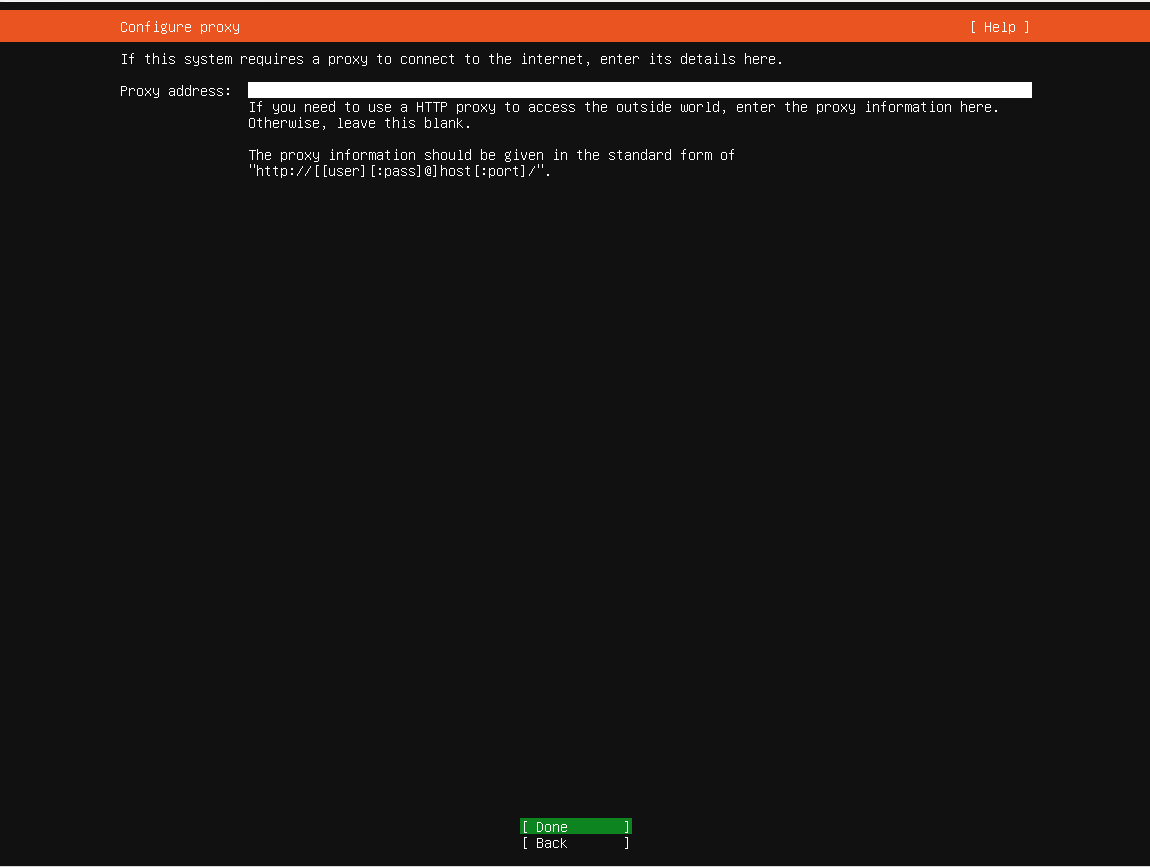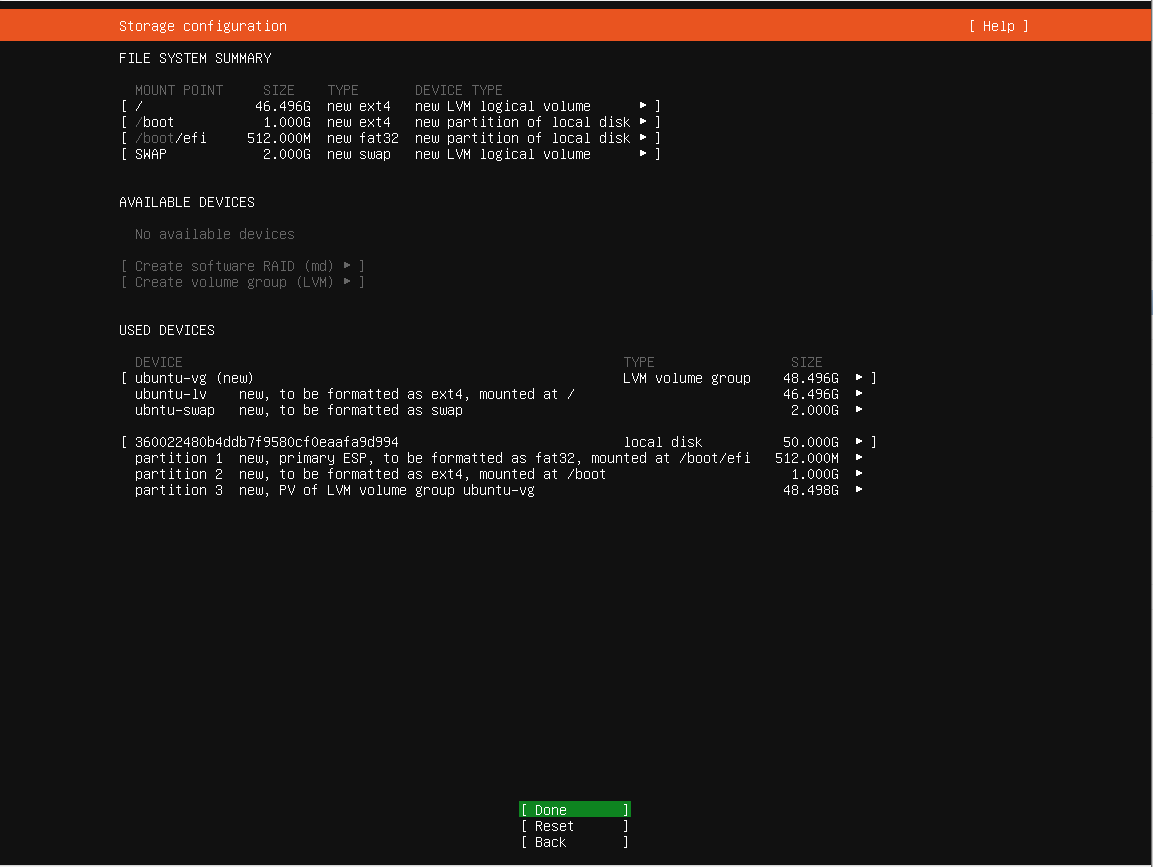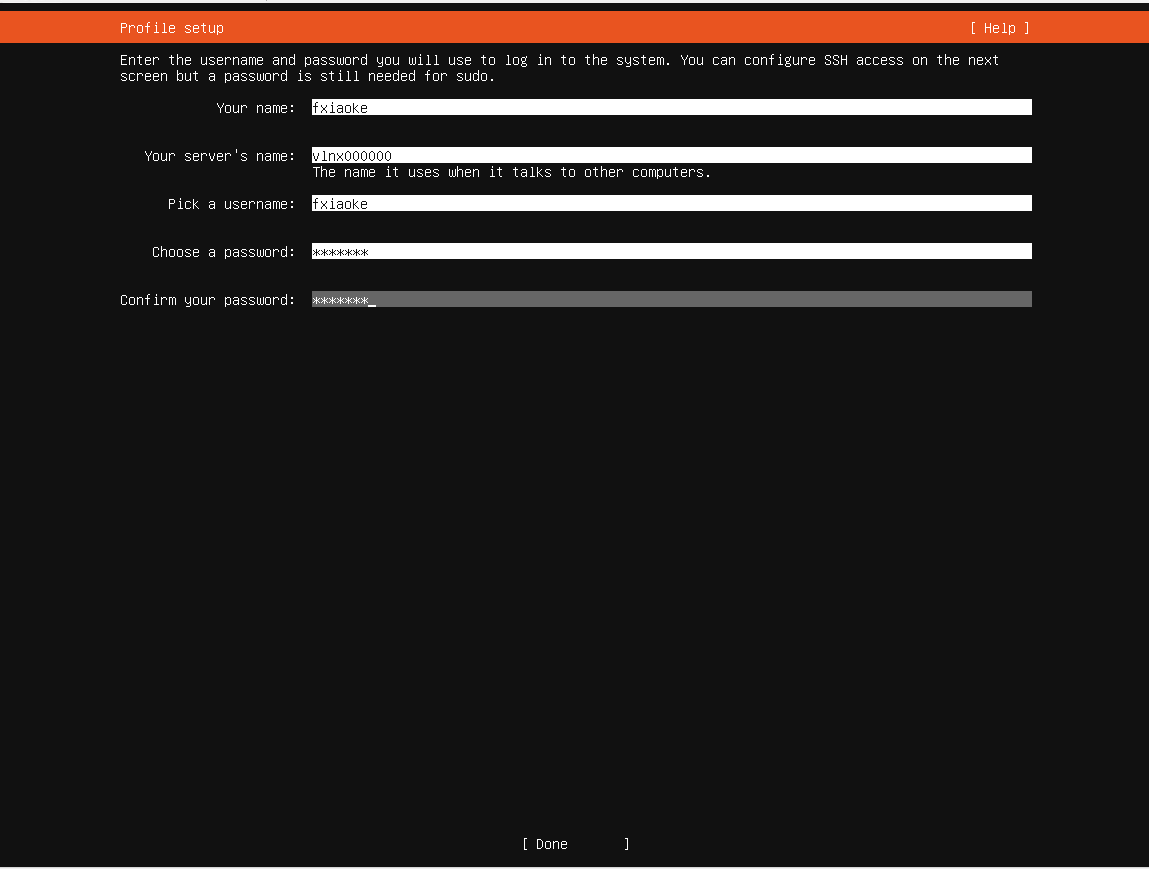制作Hyper-V的Ubuntu虚机模板
硬件准备
主机信息
- CPU:默认创建1核处理器
- 内存:1GB
- 硬盘:50GB 系统盘,使用LVM动态磁盘
- IP地址: 172.31.107.15/16
- 安装镜像:https://releases.ubuntu.com/20.04/ubuntu-20.04.2-live-server-amd64.iso (SHA256SUMS校验值为: d1f2bf834bbe9bb43faf16f9be992a6f3935e65be0edece1dee2aa6eb1767423)
- 软件源为: http://cn.archive.ubuntu.com/ubuntu
创建主机
1
2
3
4
5
6
7
8
9
10
11
12
13
14
15
16
17
18
19
20# 使用管理员权限开启PHPV153003主机的powershell控制台
# 创建虚机,并指定第二代且版本为5.0以及路径
New-VM -Name ubuntutemplate -MemoryStartupBytes 1GB -Generation 2 -Version 5.0 -Path d:\VMs\ -Novhd
# 创建硬盘文件夹
mkdir "D:\VMs\ubuntutemplate\Virtual Hard Disks"
# 创建系统盘,指定文件路径、大小、Blocksize
New-VHd -Path "D:\VMs\ubuntutemplate\Virtual Hard Disks\ubuntutemplate.vhdx" -Dynamic -SizeBytes 50GB -BlockSizeBytes 1MB
# 将新建磁盘附加到指定虚机
Add-VMHardDiskDrive -VMName ubuntutemplate -Path "D:\VMs\ubuntutemplate\Virtual Hard Disks\ubuntutemplate.vhdx" -ControllerType SCSI -ControllerNumber 0
# 添加光驱并指定iso文件
Add-VMDvdDrive -VMName ubuntutemplate -Path D:\ISO\ubuntu-20.04.2-live-server-amd64.iso
# 默认网卡不指定交换机,在安装过程中断网以免安装过程中的升级时间过长
# 设定网卡的VLAN ID
Set-VMNetworkAdapterVlan -VMName ubuntutemplate -VMNetworkAdapterName "Network Adapter" -Access -VlanId 31
# 设定主机关闭安全启动
Set-VMFirmware -VMName ubuntutemplate -EnableSecureBoot off
# 开启主机集成服务中的来宾服务
Enable-VMIntegrationService -VMName ubuntutemplate -Name "Guest Service Interface"
# 启动主机
Start-VM -VMName ubuntutemplate
系统安装
基本配置
1
2
3
4
5
6
7
8
9
10
11
12
13
14
15
16
17语言: English
键盘:English
网络:
子网:172.31.0.0/16
地址:172.31.107.15
网关: 172.31.153.253
DNS: 172.31.100.4
不使用网络代理,并使用官方源
使用自定义磁盘分区
创建1GB ext4格式 /boot 分区
自动创建512MB EFI引导分区
剩余磁盘创建不含格式分区
创建PV(CL)
创建LV:root 3.5GB
创建LV: swap 3GB
创建默认用户以及密码、主机名(VLNX000000)
安装openssh-server配置语言
配置键盘布局
配置网络属性
配置网络代理(无)
配置系统升级APT软件源
配置硬盘自动分区
配置根分区使用全部剩余空间
创建用户
安装openssh-server
选择软件包
开始安装
完成安装
系统配置
系统更新
1
2apt update
apt upgrade -y安装工具
1
2
3
4
5
6
7
8
9
10
11
12
13
14
15# 安装网络工具包
apt install -y curl wget net-tools
# 安装监控工具包
apt install -y htop iftop iotop
# 安装其他工具包
apt install -y locate unzip tree facter ruby libruby2.7
# 安装加域工具包
apt install -y sssd-ad sssd-tools realmd adcli
systemctl enable sssd
# 开启域用户登录自动创建home目录
pam-auth-update --enable mkhomedir停用无用服务
1
2
3
4
5
6
7
8
9# 关闭snapd服务和apparmo服务
systemctl disable apparmor.service snapd.service
systemctl disable snap-core18-1944.mount snapd.apparmor.service snapd.core-fixup.service snapd.seeded.service snapd.socket snap-lxd-19188.mount snap.lxd.activate.service snap.lxd.daemon.unix.socket snap-snapd-10707.mount
systemctl disable snapd.autoimport.service lxd-agent.service lxd-agent-9p.service snapd.system-shutdown.service snapd.recovery-chooser-trigger.service snapd.snap-repair.timer snapd.socket
# 停止cloud-init服务
systemctl disable cloud-init.service cloud-init-local.service cloud-final.service cloud-config.service
# 停止自动升级和信息收集服务
systemctl disable unattended-upgrades.service apt-daily.timer apt-daily-upgrade.timer apport-forward.socket apport-autoreport.path
sed -i 's/1/0/g' /etc/default/apport安装Hyper-V驱动
1
apt install -y linux-image-virtual linux-tools-virtual linux-cloud-tools-virtual
配置时间
1
2
3
4
5
6
7
8# 使用chrony管理时间
apt install -y chrony
systemctl enable chrony --now
# 使用北京时间
timedatectl set-timezone Asia/Shanghai
# 使用24小时制
echo 'LC_TIME=en_US.UTF-8' >> /etc/default/locale
echo 'LC_ALL=en_US.UTF-8' >> /etc/default/locale修改网络管理工具
1
2
3
4
5
6
7
8
9
10
11
12
13
14
15
16
17
18
19
20
21
22
23
24
25
26
27
28# 使用NetworkMangager管理网络
apt install -y network-manager
systemctl enable network-manager
systemctl disable wpa_supplicant.service
# 要将全部yaml文件移除之后再创建新的配置文件
mkdir /etc/netplan/bak
mv /etc/netplan/*.yaml /etc/netplan/bak/
# 新建配置文件
cat > /etc/netplan/01-network-manager-all.yaml << EOF
# This is the network config written by 'subiquity'
network:
version: 2
renderer: NetworkManager
EOF
# 应用配置
netplan apply
systemctl restart network-manager
# 重新配置IP信息,否则开机无法访问网络
nmcli c del eth0
nmcli c m Wired\ connection\ 1 con-name eth0
nmcli c m eth0 ipv4.addresses 172.31.107.15/24 ipv4.gateway 172.31.153.253 ipv4.dns 172.31.100.4 ipv4.method manual autoconnect yes
# 配置生效
nmcli c d eth0 && nmcli c u eth0修改SSH配置文件
1
2
3
4
5
6# 修改/etc/ssh/sshd_config
# 允许root使用密码登录
PasswordAuthentication yes
# 开启认证方式
GSSAPIAuthentication yes配置防火墙
1
2
3ufw allow ssh
ufw enable
ufw reload配置编辑器
1
2
3
4
5
6
7
8
9
10
11
12# 配置默认编辑器使用vim
# 使用第3项 vim.basic
update-alternatives --config editor
There are 4 choices for the alternative editor (providing /usr/bin/editor).
Selection Path Priority Status
------------------------------------------------------------
0 /bin/nano 40 auto mode
1 /bin/ed -100 manual mode
2 /bin/nano 40 manual mode
* 3 /usr/bin/vim.basic 30 manual mode
4 /usr/bin/vim.tiny 15 manual mode开启脚本自动补全
1
2
3
4
5
6
7
8
9
10# 去掉 /etc/bash.bashrc 第35~41行注释
# enable bash completion in interactive shells
if ! shopt -oq posix; then
if [ -f /usr/share/bash-completion/bash_completion ]; then
. /usr/share/bash-completion/bash_completion
elif [ -f /etc/bash_completion ]; then
. /etc/bash_completion
fi
fi修改默认shell为bash
1
2
3
4
5
6root@vlnx000000:~# dpkg-reconfigure dash
# 选择NO
Removing 'diversion of /bin/sh to /bin/sh.distrib by dash'
Adding 'diversion of /bin/sh to /bin/sh.distrib by bash'
Removing 'diversion of /usr/share/man/man1/sh.1.gz to /usr/share/man/man1/sh.distrib.1.gz by dash'
Adding 'diversion of /usr/share/man/man1/sh.1.gz to /usr/share/man/man1/sh.distrib.1.gz by bash'设置开机自启动脚本
1
2# 新建开机运行程序
echo '@reboot root /bin/bash /root/firstboot.sh'>>/etc/crontab启用ROOT用户并重启
1
2
3
4
5
6
7# 设置root用户密码
sudo passwd
# 更新索引和库依赖关系
ldconfig
updatedb
# 重启主机
reboot
清理交付
删除安装用户
1
2deluser fxiaoke
rm -rf /home/fxiaoke清理主机信息
1
2
3
4# 清除Machine ID
>/etc/machine-id
# 清除SSH公钥,在后续部署中会使用`dpkg -reconfigure openssh-server`来重新SSHD的key,否则无法SSH登录
rm -rf /etc/ssh/*key*扩展磁盘
1
2lvextend -l 100%free /dev/cl/root
resize2fs /dev/cl/root删除缓存
1
2
3
4
5
6
7# 清除apt缓存
apt autoremove -y
apt clean
# 清除访问历史
rm –rf /tmp/*
rm –rf /var/tmp/*
history -c关机
1
2
3# 使用带空格的命令避免存入history
sync
poweroff
备注
- 新部署的主机需要使用
dpkg-reconfigure openssh-server来重新SSHD的key,否则是登录不上22端口的; - Ubuntu 20.04 使用swap.img来替代以往的swap分区,导致在虚机部署中实际磁盘空间占用要大于centos至少一倍以上;
- 部署时使用自定义分区可以创建swap分区;
- Hyper-V虚机的默认blocksize是32M,会导致vhdx文件远远大于vmdk,建议按照官方实践指南blocksize使用1M。
All articles on this blog are licensed under CC BY-NC-SA 4.0 unless otherwise stated.
